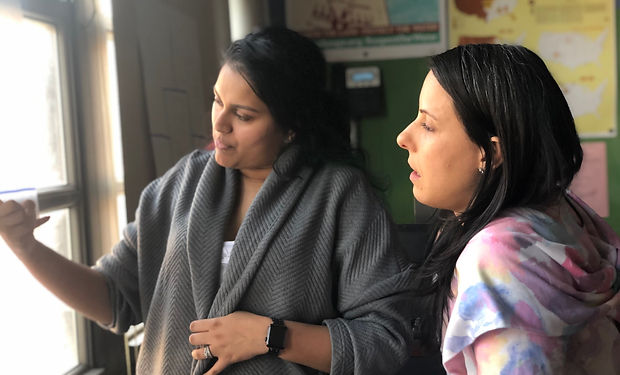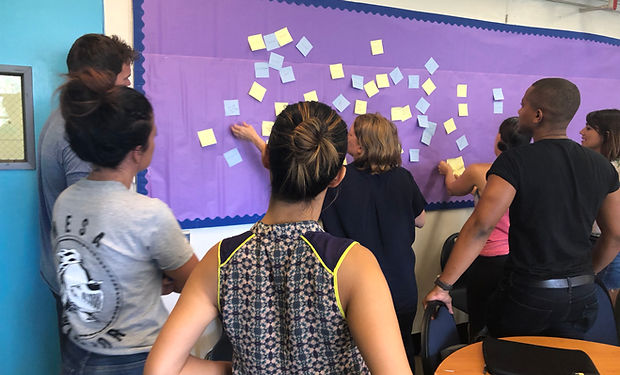Instructional Initiatives

COACHING

My top priority is to support teachers and coaches to better serve our students both academically and socioemotionally. It is important to look at coaching from not only the lens of the teacher but also from the lens of the coach. From a coach to teacher perspective, it is important to understand that coaching is very different from supervising and mentoring. Coaching, specifically, is centered around establishing a collaborative partnership to grow. Coaches are learning alongside their coachees as they work towards a common goal, which is not imposed on the coachee, but more so decided together and then developed.
Development includes entering the classroom, observing and providing feedback through the lens of that goal. It also includes sharing resources and sending teachers to PD based on that targeted goal. A big aspect of our coaching is that it is non-evaluative. We use a framework strictly for providing feedback and for a common language, not to rate a teacher. Ultimately, teachers feel supported and are excited to improve upon their practice.
In order to coach effectively, we have to coach the coaches. We have coaches meetings on a regular basis where we analyze academic data and learn skills important to coaching, such as how to have difficult conversations or how to coach specifically for behavior management or student voice. We empower coaches to share their best practices by having them facilitate many of the meetings, so it is not a top-down approach. We also have spaces where, as interdisciplinary subject teams, we meet to discuss coaching through the specific lens of humanities and math/science as those skills and content look very different, so how you coach will look different as well. We take the same approach with coaches of working collaboratively towards a common goal. Collaboration while skilling up is crucial to implementing an effective coaching program!
DATA-DRIVEN INSTRUCTION

As an Assistant Principal and instructional coach, analyzing data is critical for setting and prioritizing goals, making decisions, creating next steps, and monitoring progress. Data might include classroom formative and summative assessments, trimester exams, and Regents exams. Over the past couple of years, we have robustly developed how we use data in our instructional coaches team and interdisciplinary team meetings as well as our individual teacher-coach meetings. For example, as an instructional coaches team and Math-Science-Essentials & Humanities interdisciplinary team, we are consistently analyzing trends across the board beyond passing rates -- we are looking at the frequency and number of assessments; assessment: learning goal ratio; period by period passing rates; level of mastery of learning goals in addition to mastery by subgroups such as SWIEP, ELL, and SPELL. This then informs how we coach on an individual level as well as the next steps as an instructional team in consistent coaching practices. This has sometimes informed schoolwide changes to our grading systems in order to be most responsive to teachers and students. Furthermore, we use summative assessments such as trimester exams and mock Regents exams as periodic checkpoints towards students’ mastery of learning goals and state standards. By creating uniformed ways to collect and track data as well as provide protocols to analyze data (teacher level, department level, etc), we are able to engage in data driven instruction efficiently as an entire school. As a result, both teachers and instructional leadership are equipped with the tools to use data effectively.
VERTICAL ALIGNMENT

A couple of years ago alongside our other Assistant Principal, we initiated the school-wide vertical alignment process in all content areas as a result of there being a lack of codified resources. This became a problem because if a teacher left, there was a gap of knowledge not being passed on to a new teacher. I have directly assisted math, science, arts and physical education departments through vertical alignment of their subjects skills over the four-year course sequence at MESA. A major part of the process is delving deep into the national and state standards of their particular content standards -- whether that is Common Core Math, Next Generation Science Standards, NYS Regents Standards or the NYCDOE Arts Blueprint. Some department time is spent analyzing and grouping the standards to not only develop a better understanding but also make the standards more digestible. Teachers are also sent on external PD as well. From there, teachers develop departmental goals and skills of focus and then flush out in great detail how this skill is taught and scaffolded up from grades 9-12. This is a process that we have embedded larger chunks of departmental time during strategic times such as exam week. There are larger chunks of time available. All of this information is codified into a departmental handbook and is revisited multiple times of year to evaluate, reflect, and modify. This is a process that has no end as goals continue to shift and there is a cycle of reflection after teaching. Another important aspect to highlight is that all curricula for all classes in the department are linked in these handbooks for easy access.
ARTS & PHYSICAL EDUCATION =
ESSENTIAL SUBJECTS

We value our arts and physical education departments to a similar extent as our “core” content teachers. This is why we have reframed those departments as “essential subjects,” with the understanding that both subjects are necessary for life. For example, the arts (which we offer visual arts, music, and dance) offer important outlets for students creatively and socially emotionally. Physical Education is crucial to living a healthy lifestyle and also serves as an outlet for many of our students. Similar to our departments, they have department meetings where they engage in vertical alignment based on NYCDOE Arts Blueprint and NYS Wellness Standards respectively. For example, I recently developed a protocol and facilitated a conversation for each department to reflect on the strengths and challenges in their classrooms (with supporting evidence) of each aspect of their standard and then devise the next steps to improve as individual teachers. In addition, I coach these teachers to the same high level of expectation and devote the same amount of time as our other teachers through curriculum development, unit planning, and data-driven instruction while ensuring that they receive similar access to external professional development opportunities (workshops, conferences).
STREAMLINED ACADEMIC OPERATIONS
_JPG.jpg)
This was a result of a gap I discovered as I took over many aspects of academic operations. After our former Director of Operations left, I realized that we did not know how critical aspects of our school year worked such as advisory conferences, report cards, and trimester exams. I felt unequipped to take over leading these aspects of our school alongside our new Director of Operations. I was often left trying to put pieces to the puzzle together through various emails and older documents. As a result, I decided that as I was learning a new aspect of my position, I would also develop structures to streamline and systematize academic operational systems including advisory conferences, report cards, trimester exams, and other interim data, intersession, and Regents exams. I continuously revisit these systems to modify and tighten. As a result, three years into this process, our systems have become automatized and they are documented for any future leader. In addition, I am working alongside our Associate Director of Operations to develop a handbook to systematize all aspects of the school, not just academics.
PROFESSIONAL DEVELOPMENT
During my time as Assistant Principal, the instructional school leadership team and reorganized professional development - both internally and externally, so that it is teacher-centered and teacher-chosen as well as directly aligned with our instructional goals. For example, in our pre-planning stages, the instructional coaches team identified the school-wide foci for the year, which has shifted over time based on both qualitative (classroom visits, staff surveys, etc) and quantitative (assessments) data. For example, a couple of years ago, we focused on student discourse, writing, and modalities. Teachers then had the opportunity to choose their pathways. This year, being responsive to the needs of our school staff survey, we are now focusing on critical thinking and problem-solving. We then created a scope and sequence and calendar for how professional development would look like. Part 2 of the process is turnkeying to the staff, which occurs during our two-week-long Summer Institute. This is where the leadership team, in conjunction with teacher coaches, foster buy-in and introduce the instructional focus for the year and roll out our professional development calendar. In terms of implementation of professional development, one critical aspect is our once a month 2-hour long workshop on an aspect of the instructional focus. During these sessions, teachers have the opportunity to share out their best practices. We also have shorter sessions once a month on other school initiatives such as Hochman and Student Support for ELLs/SWIEPs. Connections are made through department meetings, which occur twice a month. We have the biggest buy-in through our yearly share-a-thon, which takes place on one of our full-day professional development spaces. On these days, there are workshops and presentations of best practices for staff by staff. This includes not just instructional staff, but all staff including the counseling team, college counseling team, deans, and operations. I work closely with our Professional Development Coordinator to make this happen, on both a developmental and logistical front. An additional aspect of professional development that I have created and continue to lead in ensuring that our teachers have access to quality workshops and conferences outside of school.
